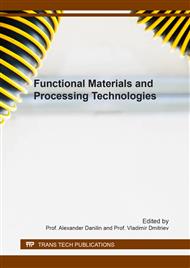[1]
H.E.G.M.M. Bakr, Diatomite: Its Characterization, Modifications and Applications, Asian J. Mater. Sci. 2 (2010) 121-136.
Google Scholar
[2]
P.S. Vassileva, M.S. Apostolova, A.K. Detcheva, E.H. Ivanova, Bulgarian natural diatomites: Modification and characterization, Chem. Pap. 67 (2013) 342-349.
DOI: 10.2478/s11696-012-0272-x
Google Scholar
[3]
V. P. Il'ina, T. S. Shelekhova, Diatomites of Karelia for glass production, Class Ceram. 66 (2014) 109-112.
DOI: 10.1007/s10717-009-9139-1
Google Scholar
[4]
D. Jang, L.R. Meza, F. Greer, J.R. Greer, Fabrication and deformation of three-dimensional hollow ceramic nanostructures, Nat. Mater. 12 (2013) 893-898.
DOI: 10.1038/nmat3738
Google Scholar
[5]
P.I. Peretyat'ko, L.A. Kulikov, I.V. Melikhov, Yu.D. Perfil'ev, A.F. Pal', M.A. Timofeev, S.A. Gudoshnikov, N.A. Usov, Magnetic porous composite material: Synthesis and properties, Tech. Phys. Lett. 41 (2015) 974-976.
DOI: 10.1134/s1063785015100260
Google Scholar
[6]
G. Dong, Z. Su, J. Wang, Diatomite modification and its application wastewather treatment, Adv. Mater. Res. 850-851 (2014) 1355-1359.
DOI: 10.4028/www.scientific.net/amr.850-851.1355
Google Scholar
[7]
N. van Garderen, F.J. Clemens, M. Mezzomo, C.P. Bergmann, T. Graule, Investigation of clay content and sintering temperature on attrition resistance of highly porous diatomite based material, Appl. Clay Sci. 52 (2011) 115-121.
DOI: 10.1016/j.clay.2011.02.008
Google Scholar
[8]
M. Hosokawa, K. Nogi, M. Naito, T. Yokoyama, Nanoparticle Technology Handbook, 2nd edition, Elsevier, Amsterdam, Boston, (2012).
Google Scholar
[9]
J. Lou, R. Stevents, Porosity-dependence of elastic moduli and hardness of 3Y-TZP ceramics, Ceram. Int. 25 (1999) 281-286.
DOI: 10.1016/s0272-8842(98)00037-6
Google Scholar
[10]
A.G. Romashin, M. Yu. Rusin, F.Y. Borodai, Structural ceramic and fibrous materials based on quartz glass, Refract. Ind. Ceram. 45 (2004) 387-391.
DOI: 10.1007/s11148-005-0018-1
Google Scholar
[11]
J. Dongchan, L.R. Meza, F. Greer, J.R. Greer, Fabrication and deformation of three-dimensional hollow ceramic nanostructures. Nat. Mater. 12 (2013) 893-898.
DOI: 10.1038/nmat3738
Google Scholar
[12]
L. Han, K. Miyasaka, O. Terasaki, Electron crystallography, in: D.W. Bruce, D. O'Hare, R.I. Walton (Eds. ), Structure from Diffraction Methods: Inorganic Materials Series, John Wiley & Sons, USA, 2014, pp.201-258.
DOI: 10.1002/9781118695708.ch4
Google Scholar
[13]
Y. Han, Y. Zhu, D. Zhang, Structural Diversity in Ordered Mesoporous Silica Materials, in: Q. Zhang, F. Wei (Eds. ), Advanced Hierarchical Nanostructured Materials, Wiley-VCH, Germany, 2014, pp.1-34.
DOI: 10.1002/9783527664948.ch1
Google Scholar


